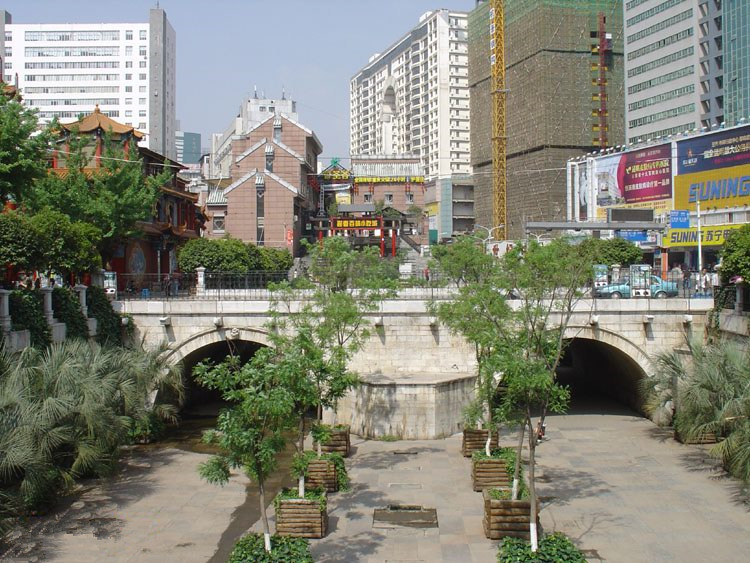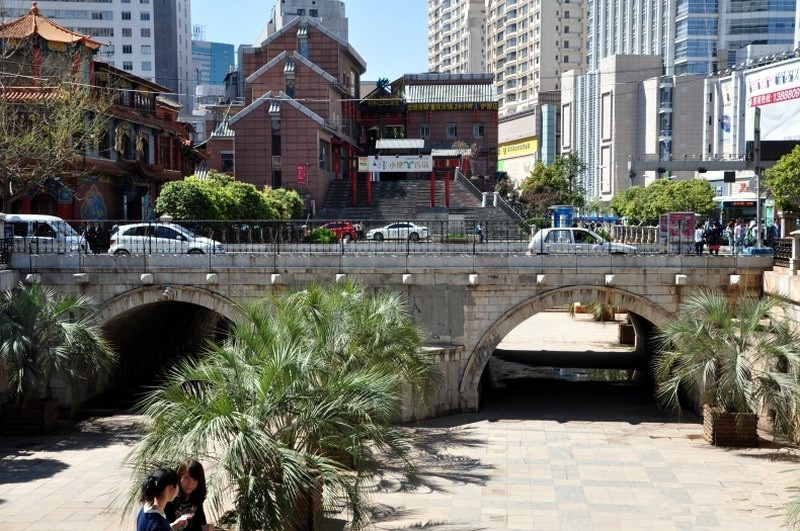Huguo Bridge in Kunming
Huguo Bridge (护国桥) is located in the middle section of Huguo Road in Kunming, Yunnan Province. With a length of 23 meters and a width of 17.5 meters, this dual-arch stone bridge showcases a blend of Chinese and Western architectural styles, exuding an ancient and elegant charm. Huguo Bridge is a historical commemorative building related to the significant historical event known as the Huguo Movement. Along with Huguo Gate (护国门) and Huguo Road (护国路), it was built in 1919 and is considered one of the three major projects commemorating the victory of the Huguo War in Yunnan. Huguo Bridge not only serves as a commemorative structure but also reflects the architectural style of traditional dual-arch stone bridges in China while incorporating influences from Western architectural culture. In 2003, it was designated as a provincial cultural relic protection unit.
Geographical Location:
- Yunnan Province, Kunming City, Huguo Road (云南省昆明市护国路中段)
- Length: 23 meters
- Width: 17.5 meters
Overview
The Huguo Gate, Huguo Bridge, and Huguo Memorial Monument together form Huguo Square, located at the intersection of Huguo Road and Dongfeng Road in Kunming, Yunnan Province. The square consists of two parts: Huguo Bridge Square and Cultural Square.
Huguo Bridge Square
- Covers an area of 31,111.56 square meters, including a green space of 620 square meters.
- Centered around the 17.5-meter wide Huguo Bridge, with sunken squares on either side measuring 32.5 meters in length, 23 meters in width, and 4 meters in depth.
- Each side features 29 steps leading to the bottom of the square, utilizing the two bridge openings as pedestrian passages.
Cultural Square
- Located to the west of Huguo Bridge Square, covering an area of 2,029.01 square meters.
- Styled in ancient architecture, with 1,441 square meters underground and 3,283.5 square meters above ground.
Huguo Gate, Huguo Bridge, and Huguo Memorial Monument were built to commemorate the Huguo Army, formed in December 1915 when figures such as Tang Jiyao (唐继尧) and Cai E (蔡锷) issued a telegram in Yunnan to mobilize against Yuan Shikai.
The Huguo Gate features an iron gate supported by four columns with three openings, measuring 18 meters in length and 5 meters in height, with a lattice structure on the upper part and cast patterns on the lower part. The gate was dismantled during the 1950s when the Ming Dynasty brick city of Kunming was demolished and was relocated to the entrance of the Workers’ Cultural Palace. During the Cultural Revolution, it was removed again for the construction of “Red Sun” Square. In 1995, a new foundation and railing were built, and the Huguo Gate was reconstructed at its original site, covering approximately 700 square meters.
Development History
Huguo Bridge was constructed in 1919 as an elegant dual-arch stone bridge that reflects both Chinese and Western architectural styles, measuring 23 meters in length and 17.5 meters in width. The arch rings, water divider, bridge edges, and railings exhibit a graceful European style. The dragon head, dragon tail, and elephant head showcase strong ethnic characteristics and local features, demonstrating high craftsmanship and artistic value. The bridge was filled in during the urban renewal of 1952. However, it was uncovered on January 20, 1999, during cable tunnel construction.
The monument stands as a three-sided pyramid shape, made of bronze, with a total height of 8.4 meters. It features the inscription “Huguo Uprising Memorial” on its side. The square stone base measures 2 meters on each side and 1.5 meters in height, engraved with the inscription and relief depicting the Huguo Uprising’s events.
In June 1999, the Kunming Municipal Committee of the Communist Party and the city government decided to restore Huguo Bridge. The construction was overseen by Panlong District. A project command group was formed to fully implement the work. The square construction required the use of 5,140.57 square meters of land, involving land from various entities, including Tianheng Hotel, Yunnan Provincial Postal Savings Bureau, and Nanping Garment Factory, as well as some private residences. Through multiple efforts, 26 households were relocated from August 10 to September 10, 1999, and 5,600 square meters of dilapidated houses were demolished.
The construction of Huguo Bridge Square was put to tender, with the main construction carried out by the Fourth Engineering Department of the Fifteenth Bureau of the Ministry of Railways. The Lu Liang Dadi Stone Material Company handled the stone masonry, while Kunming Jianlong Supervisory Company provided project supervision. The municipal quality inspection station and the city quality inspection station conducted quality oversight for the project, and the Panlong District Greening Office was responsible for the associated landscaping work.
Greening Design
The greening design for Huguo Bridge Square aimed to create a cohesive landscape with the green space adjacent to Tianheng Hotel, achieving a harmonious and natural aesthetic. The design preserved a landscape tree, a small leaf privet (小叶女贞), from the former Chunman Park and introduced two osmanthus trees, two apricot trees, three cycas trees, twelve boxwood balls, 4,100 golden cypress plants, various flowering plants, and 4,000 colorful grass plants. It also included 440.37 square meters of early-maturing grass and 20.07 square meters of lotus grass, utilizing a three-dimensional planting method to create a unique landscape that showcases the beautiful transformation of Huguo Bridge Square.
The sunken square beneath Huguo Bridge was completed on April 11, 2000, and the Cultural Square was finished in October 2000, with a total investment of 40 million RMB. The municipal government covered 5 million RMB, while the remaining expenses were borne by the Panlong District government.
Huguo Square serves as a memorial site for Kunming’s historical cultural landmark, the “Huguo Uprising,” as well as a city green space.



















